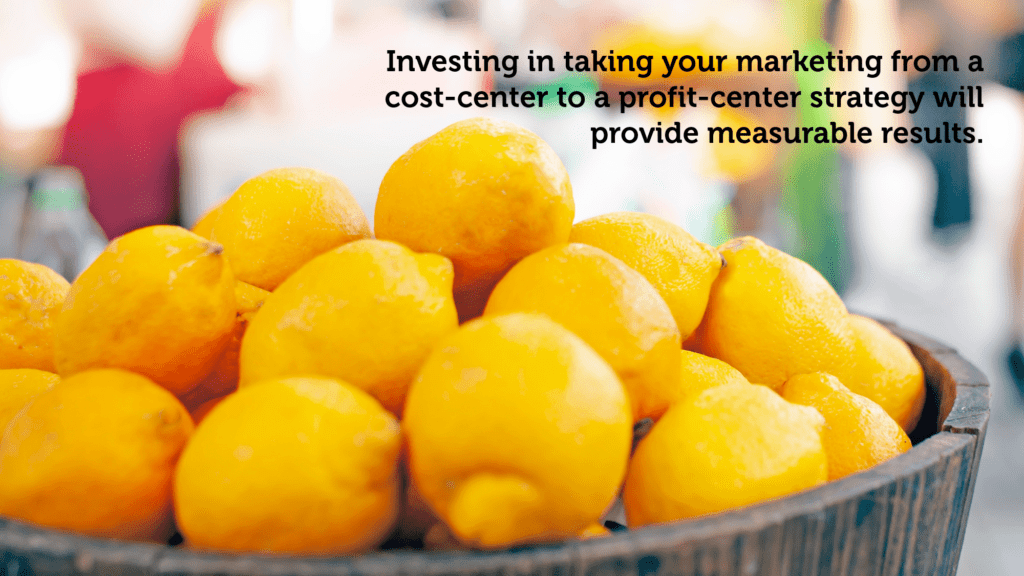So, You Want to Turn Marketing into a Profit Center?
Most businesses have marketing designing brochures, writing blogs, and posting on social — getting the brand “out there.” But where, exactly, is out there? Why is one marketing approach better than another? If businesses can’t answer these questions, they’re missing valuable opportunities to drive revenue.

What is Profit-Center Marketing?
Profit-center marketing is when the marketing function generates measurable revenue for a company. “Profit centers” are named as such because they make a measurable impact generating profits, which has long been seen as a sales function. For many companies, marketing is considered a “cost center,” in that it costs the business more money than it makes back. Cost-center marketing departments might help with brand awareness or general coordination of marketing tactics (e.g., website, social, or events), but then their salespeople take prospects through the journey from awareness through to consideration and the decision to buy.
Moving marketing into a profit center requires giving it a larger role in the revenue funnel.
First, the marketing department should identify the “right” leads — those that will benefit from what the company does best and drive future company growth. Marketing should also remember that today’s buyers proactively buy, and they don’t want to be sold to before they are ready. So the effort should be focused on supporting the “right” leads through their knowledge gathering and research into solutions.
Over time, as marketing content moves leads further through the revenue funnel (i.e., consuming marketing content, exploring the website, downloading materials), the sales team doesn’t have to cover as much ground turning leads into prospects into customers. Profit-center marketing effectively helps sales spend less time cold calling or “knocking on doors” of people who aren’t ready. Marketing has already warmed up leads before handing them over.
Taking a growth marketing mindset can help you transform marketing into a profit center. Profit-center marketing begins with research to identify market opportunities and target audiences. Marketing materials are developed with those areas and people in mind. Content is personalized to nurture education and guidance and drive traffic through the funnel to reach sales. As your understanding of the audience evolves, so should your materials, approaches, and measurement.
The profit-center marketer combines targeted content with more tracking to get specific about what actions in the revenue funnel mean. For instance, the logic might evolve into something like:
- For every 100 blog views, we expect three downloads of an awareness resource.
- For every 10 of those downloads, two visitors will download a service sheet.
- One of those two should be a real sales qualified lead.
That level of perspective over marketing activity and its impact on driving leads can help the marketing function focus energy on the work that matters most.
Profit-center marketing, done successfully, turns marketers into the trusted gravitational force for the company. At critical mass, marketing can quantify the number of opportunities generated and qualified based on the leads’ interactions with the brand’s touch points. And if those leads close, they should be viewed as marketing profit!
Why Make Marketing a Profit Center
You don’t need an MBA to favor making profits over covering costs. However, too many businesses still rely on cost-center marketing, where marketing activities are typically scattershot. There may be a lot going on, but there’s no clear idea of who that busy marketer is trying to reach or the best way to communicate to those people.
We see companies who make their marketing decisions based almost entirely on what one or two competitors are doing. “They made a video? We should too!” They don’t know what works and what doesn’t, and they simply try whatever they can think of in order to keep pace. It’s unsatisfying for any marketing coordinator stuck doing a bunch of things that don’t really matter. And it’s unrewarding for the company that sees no return.
A profit-center marketing department doesn’t just add “more people” or “more marketing channels” or “more marketing materials” to see what sticks. It focuses on being consistent, having a good plan, and knowing where to invest dollars in the initial build and outreach over time.
Taking a profit-center approach, marketing creates checkpoints along the way as prospects travel on their buyer’s journey. All marketing speaks to the specific target audience and meets a particular objective. By tracking activity, the marketer gains a better understanding of what should happen, when.
With ongoing analysis of the marketing efforts and their direct impact on revenue, profit-center marketing is structured to enable predictive capabilities. In the long-term, this can do away with reactive money spend. (“Ack, a conference is coming up, we need a brochure!”) Because the marketing team has developed a scalable roadmap, budget allocation is more strategic.
When you’ve turned marketing into a profit center, it’s more organized and more cost-effective. Profit-center marketers also make the sales department’s job easier. With lead generation efforts aligned closely with larger business objectives, marketing is focused on boosting the volume of quality opportunities given to sales to close.
Who Benefits from Profit-Center Marketing
Transforming your marketing into a profit center can benefit any organization. After all, marketing that is strategically aligned to business objectives, and measured for its revenue generation impact, isn’t about busy work.
When marketing is a profit center, you’re investing in assets that make a measurable difference instead of paying for campaigns that don’t really add up to anything. Profit-center marketing provides a context — why is marketing doing what they are doing? — and a measurable purpose. With this focus, marketing’s importance in the organization rises. It’s no longer sitting alone at lunch watching all the popular kids laugh together. Instead, marketing earns a seat at the table working alongside the executive team to formulate strategy and drive revenue and marketing opportunities going forward.
That said, some businesses are better suited to profit-center marketing than others. It helps if marketing and sales are already working together to score and qualify leads. If marketing is siloed, it’s a good idea first to build bridges to the rest of the organization before making the transition to marketing that is profit centered.
We tend to partner with high-growth companies, which want to grow in the double digits and are better able to justify the effort to build out this type of marketing machine. It takes time and money to make the shift to a profit-centered approach. Typically, year one is an investment year. In year two, all the research, road mapping, and rebuilding of the marketing funnel will begin paying off. Then, it just continues to grow, and because it is so structured, it’s something that can scale well.

Now that you’re convinced of the value of turning marketing into a profit center, you’ll be wanting to know how to get started on the transformation. Our next blog offers insights into what is needed for a successful transformation and what happens when you do it well.
Looking for expert guidance and support as you transform marketing into a profit center? We can help. Marketri’s team delivers results-driven marketing services to accelerate and scale repeatable revenue generation. Learn more about our four-pillared approach today!
Want More?
If you’re interested in learning more about strategic marketing plans and how they play a role in growing businesses, then download our guide by clicking the image below.






